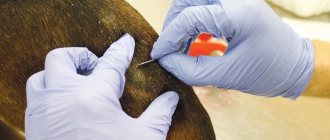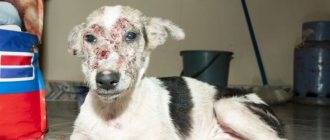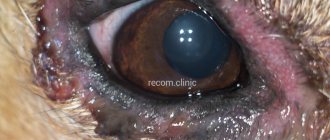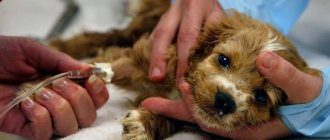Subcutaneous tick on a dog. Photo
What disease can lead to serious consequences for a dog’s body or even death?
The most common and dangerous disease in dogs is demodicosis. At the initial stage, signs of infection with subcutaneous mites appear mildly and are not noticeable. However, you shouldn't relax. The following breeds are susceptible to this skin disease: Rottweiler, Boxer, German Shepherd, Collie, Smooth-haired Dachshund, as well as French and English bulldogs, Scotch Terrier, Sheltie and West Highland White Terrier.
What kind of disease is this
Demodex canis, Demodex cornei, Demodex injai mites live in the sebaceous glands, hair follicles and the spaces between them. Another name is glandular , that is, living in the glands. Ticks feed on gland secretions. Arthropods crawl to the surface of the skin and eat the exfoliated epithelium. The size of the imago does not exceed 0.2 mm, so it is not possible to detect the tick without the help of a microscope.
A cohabitant becomes an enemy when the immune forces lose the ability to restrain reproduction. There is not enough food for mature ticks, larvae, and nymphs; they devour glands and the surrounding space. Capillaries are destroyed, ichor appears, which serves as a substrate for the development of fungi and bacteria, which are always present on the skin and the surrounding air.
Demodicosis affects puppies, adolescents, and older animals. The following breeds of dogs are most often affected:
- Boxers;
- Dobermans;
- German Shepherds;
- Rottweilers;
- Dachshunds;
- French bulldogs.
The disease becomes chronic and continues for years. Death occurs as a result of exhaustion or blood poisoning.
The development cycle from egg to adult in the summer or at room temperature lasts 2 weeks. In dogs living outside, the development of arthropods slows down by half in cold weather. Therefore, the peak incidence occurs in the warm half of the year.
Ticks cannot live outside the body for more than an hour, but experts have differing opinions about the possibility of tick transmission between pets. Some say that a healthy dog cannot become infected from a sick one, while others admit this possibility.
Close-up photo
Localized (focal)
It is considered the mildest form, also called “scaly” demodicosis. Most often, it manifests itself in immune deficiency during pregnancy, after childbirth, or through direct contact with an infected person. It occurs as reddening of the skin on the neck, abdomen, around the eyes and behind the ears. Foci of inflammation are few (3-5).
The animal itches, becomes irritated and nervous. In place of redness, scales of keratinized skin appear. The epidermis may thicken and crack. Acne rashes are often visible.
The disease has 2 development paths:
- The animal recovers on its own within 1-3 months (often, veterinarians do not even prescribe special medications), this option occurs in 85-90% of cases;
- The localized form will turn into a complicated generalized form, in which case it will not be possible to do without treatment.
In the photo Localized (focal) demodicosis
Generalized
This form of the disease can be a severe stage of development of the scaly type. The disease progresses to the stage of the tick spreading throughout the body. First of all, the skin suffers, and other foci of inflammation appear. Gradually, the entire epidermis becomes covered with scabs and swells. The animal emits a terrible odor due to the rotting process. Without treatment, the pet goes completely bald in 1-3 months .
The disease can disappear on its own if the immune cells begin to work effectively in time. The most positive forecasts for pets under 4 years old . The older the dog, the more difficult it is to cure demodicosis (except for cases of infection in puppies).
The danger of this form lies in the fact that the tick, which has not found food in the epidermis, gnaws its way to the organs. Therefore, generalized demodicosis can lead to problems with digestion, cardiac and circulatory systems, and lungs. The pet will suffer from vomiting, diarrhea, seizures, and general malaise. This condition may appear within 5-10 months if treatment is refused.
In the photo Generalized demodicosis
Juvenile
This is a subspecies of the generalized type. It differs in that it is diagnosed in puppies up to one year old. It is transmitted from a sick mother to offspring. Doesn't cause any particular inconvenience. The main symptom is baldness around the eyes and redness of the skin. Such demodicosis is treated only after the puppy gets stronger. Often, the immune system copes with the tick on its own.
The photo shows juvenile demodicosis
Pustular
A subtype of demodicosis that occurs both independently and as a result of an untreated scaly type. A distinctive feature is that nodules form in bald areas, turning into pustules filled with pus. These appear as reddish or brown blisters. After 3-4 weeks they burst, the secreted liquid dries and forms scabs. During this process, the dog emits a terrible odor.
Treatment of such a disease requires not only stimulation of the immune system, but also disinfection of the destroyed epidermis. With the pustular type, the dog is defenseless against surrounding fungi, viruses and harmful bacteria.
Without proper treatment, pustular demodicosis not only develops into generalized demodicosis, but also entails other infectious diseases; cases of blood poisoning have been recorded.
Pictured is pustular demodicosis
Otodemodecosis and podomodecosis
Varieties of focal localized demodicosis may be part of generalized one.
- Otodemodecosis is inflammation inside the ear. The pet is bothered by severe itching around and inside the ear, black crusts appear, and hair falls out in the ear canal.
- Pododesodecosis is an inflammation of the epidermis on the paws. Symptoms do not change; cellulite and venous suppuration often appear. Spaniels are prone to the disease. Most often, the disease spreads to all 4 limbs.
Otodemodecosis in dogs
Forms
Veterinarians distinguish between a juvenile disease, which affects young animals under two years of age, and demodicosis in adult pets. Based on the size of the affected area, a local form and a generalized form are distinguished. Clear criteria for determining differences were not established, so diagnosticians decided to consider the disease generalized if more than four spots with a diameter exceeding 25 mm were found on the dog’s skin. With systemic demodicosis, the spots merge and spread over an area of more than 31.4 cm2. For clarity, I show close-up photos of different forms of demodicosis.
The local form of demodicosis is divided into the following types:
- Scaly or squamous: single hairless spots appear. The skin is peeling. Puppies older than three months get sick. The weakening of immune defense is associated with hormonal changes that complete each of the stages of growth and development of the animal. Pets with a strained immune system recover without treatment. In animals with weakened defenses, the local form of demodicosis becomes generalized.
Scaly demodicosis - Pyodemodecosis or pustular form characterized by the appearance of a rash. Inside the pustules there is a viscous content that smells bad. Pyodemodecosis develops from a scaly form or occurs independently.
Pustules with demodicosis - Generalized form develops from focal with improper treatment or its absence. The dog owner aggravates the severity of the disease when he changes the dosage of the medication or discontinues the drug if he sees that the pet's condition has improved. Demodex activation occurs as a response to other skin diseases.
Generalized form of demodicosis
With systemic demodicosis, intoxication develops and internal organs are affected. The waste products of mites, bacteria, fungi, and metabolites of dying tissues are absorbed into the blood and have a harmful effect on the liver, kidneys, and hearts. During the autopsy of dead animals, laboratory assistants select pathological material for histological examination and detect demodexes in the parenchyma. Experts suggest that dead parasites are carried into internal organs through the bloodstream, since they cannot survive in anaerobic conditions.
Demodicosis and its manifestations in dogs
As we can see from the above, not all forms of this disease manifest themselves externally. Therefore, let us consider their characteristics in accordance with the classification of forms proposed by experts:
| Form of demodicosis | |
| focal | generalized |
| several patches (three to five) of bald skin | spots on skin without fur are constantly increasing in size and number |
| These spots show signs of peeling | the skin at the site of infection peels and thickens, has an unpleasant odor, and acquires a reddish or gray tint |
| The location of the spots is chaotic: · on the chest; · on the head; · on the stomach; · on the paws. | spots are located all over the body |
Causes
Uncontrolled reproduction of subcutaneous mites is caused by the following factors:
- Genetic predisposition.
- Unsatisfactory living conditions.
- Inadequate feeding.
- Adynamia in indoor pets combined with overfeeding.
- High load with poor nutrition or adynamia with an abundance of food.
- Stressful situations associated with transfer from an enclosure or kennel to an apartment or back.
- The owner does not expel fleas and leaves.
- Hormonal imbalances after using drugs that suppress sexual arousal.
- Hypothyroidism is an insufficiency of the thyroid gland.
- Diabetes.
- Adrenocorticism or Cushing's syndrome.
- Treatment of dermatitis of allergic etiology with immunosuppressive drugs.
- Consequences of infectious diseases.
- Side effects of antibiotics.
- Complications after vaccination.
- Age-related changes.
- Tumors.
In most dogs, the cause of decreased immunity cannot be determined after the initial examination.
Symptoms
Mature mites emerge from the hair follicle or sebaceous gland, crawl along the skin, climb hairs and penetrate other follicles. When the number of parasites reaches 200, the following clinical symptoms appear:
- alopecia, hairless areas near the eyes are called “demodectic glasses”;
- the skin becomes red, rough, itchy;
- pustules form and burst, releasing foul-smelling clay-like contents;
- the dog loses its appetite;
- a depressed state develops;
- the ichor is secreted, dries out, and scabs form;
- under the crusts, ideal conditions arise for anaerobic microflora, and dry or weeping eczema develops.
- body temperature drops or rises;
Demodectic glasses
Eczema
Demodicosis occurs in each animal with individual symptoms. The activity of subcutaneous mites causes ceruminous otitis media. The dog scratches his ears furiously. Ear wax profusely discharges from the ear canal.
Ceruminous otitis media
In the generalized form of demodicosis of the paws, pododermatitis occurs. The dog does not lean on the limb, wounds appear between the toes. Ticks enter into a symbiotic relationship with staphylococci and fungi. The affected skin becomes a breeding ground for all microbes and arthropods.
Demodectic pododermatitis
How does a tick spread?
Demodex Canis is transmitted through direct contact between animals in so-called zoozones. In these cases, the disease manifests itself precisely on those parts of the body with which the four-legged animals most actively contact each other. These are the muzzle, lips, ears, eyebrows, eyelids, chest and front legs.
The main difference between demodicosis and other diseases is that a healthy pet with a strong immune system is practically not susceptible to infection, even through direct contact with a sick dog. As a rule, pets with weak immune systems or four-legged animals with damaged skin are at risk.
Treatment
To make a diagnosis, clinical symptoms are analyzed, anamnesis is collected, and microscopy of mites is performed in skin scrapings at the border of the affected and healthy tissue. If clusters of parasites are found, then a diagnosis of “Demodectic mange” is made. If single demodexes are detected in scrapings, additional studies are prescribed to exclude or confirm the following diseases with similar symptoms:
- Otodectosis;
- Sarcoptic mange;
- furunculosis of a bacterial nature;
- mycotic dermatitis;
- alopecia of autoimmune or hormonal origin.
A veterinarian develops a treatment strategy for demodicosis in a dog, depending on the form and severity of the pathological process. The following means are used:
- insectoacaricides;
- antibiotics;
- antimycotics;
- restoratives;
- hepatoprotectors;
- detoxifiers;
- veterinary feed mixtures.
The scaly form of demodicosis in a young dog is not treated. Most often, the pet recovers. When the disease becomes generalized, the animal should be treated with acaricidal drugs. A pet with a confirmed diagnosis is excluded from breeding, since the predisposition is inherited.
Treatment of the pustular form of demodicosis begins before the final diagnosis is made. Use external acaricidal agents and symptomatic drugs at the discretion of the veterinarian. To speed up recovery, the pet is transferred to veterinary nutrition.
The treatment strategy for generalized demodicosis involves a combination of external acaricidal agents, tablets for the destruction of subcutaneous mites, fleas and other blood-sucking arthropods. With systemic tick-borne infection, internal organs are damaged, so hepatoprotectors, immunomodulators, detoxicants, and general restoratives are prescribed. The veterinarian prescribes antibiotics and antimycotics, if necessary.
Diagnostics
The symptoms and treatment of acariasis are well known to veterinarians. But before you find out how to treat subcutaneous mites in dogs, a specialist must examine the animal.
Diagnosis of demodicosis involves a doctor studying clinical symptoms, as well as taking scrapings from pathological areas of the skin.
When making an accurate diagnosis, the factor of heredity is taken into account. And if puppies are sick, the mother is also tested.
To determine the presence of mites, scraping is done so deep that blood leaks out. In the complicated form of the disease, many adult parasites and future offspring of parasites are identified. If no mites are found in the biopsy specimen, but the clinical picture clearly makes it clear that they are present, then a repeat scraping is performed. In this case, the biomaterial is collected from another affected area.
Drugs for treatment
In the 30s of the twentieth century, demodicosis was an incurable disease. An English veterinarian described his unsuccessful experience of treating ironworm in the story “Zolotinka” https://litresp.ru/chitat/ru/Х/herriot-dzhejms/sobachji-istorii/47.
In the second half of the last century, Ivomec appeared - an effective injection drug that expelled worms, exterminated fleas and subcutaneous ticks. In 1987, deworming was carried out in an English kennel for Collie dogs. All the animals died. Subsequently, it turned out that drugs based on ivermectin, doramectin, and aversectin cause paralysis not only in insects, but also in dogs of certain breeds. Therefore, experts do not recommend using these drugs in the form of injection solutions or ointments. In the last decades of the twentieth century, veterinary medications based on Amitraz were successfully used to treat demodicosis. It turned out that the drugs have many side effects and contraindications.
Complex treatment involves the use of insectoacaricides, symptomatic remedies, and medications that strengthen the immune system. To kill ticks, the following drugs are used against demodicosis:
- Amidel gel Neo : the manufacturer used the recognizable name Amidel-gel. The previous drug contained amitraz. The new product is based on the insectoacaricide cyfluthrin, includes the antimicrobial component chloramphenicol and the anesthetic lidocaine. The gel is released in dispensing syringes. The affected area is freed from crusts and 1 cm of healthy tissue is captured. Do not allow licking. The gel is applied 5 times with an interval of 5-6 days.
- Amit-Forte is a solution, released in pipettes or vials. The manufacturer replaced the toxic amitraz with the relatively harmless fipronil. Amit Forte is used in the same way as Amidel-gel Neo.
- Advocate - drops on the withers, active ingredients - imidacloprid, moxidectin. To treat demodicosis, drops are applied to the animal’s back 2-4 times with an interval of 4 weeks. The drug protects pets from fleas. lice, lice, helminths.
- Shampoos - Davis Benzoyl Peroxide or Doctor - contain benzoyl peroxide. The procedure for using the detergent is determined by the veterinarian.
- Bravecto is available in tablets, the active ingredient is fluralaner. The drug destroys ixodid ticks, fleas, lice, demodexes, and otodectes. Bravecto is given once, when the need arises, the tablets are re-fed after 12 weeks.
- Simparica is a tablet in which sarolaner acts as an arthropod killer. The active component maintains the acaricidal concentration for 4 weeks.
It is impossible to cure generalized demodicosis with destructive drugs alone. Depending on the accompanying pathological signs, methods of symptomatic therapy are used. In case of large-scale skin lesions, the veterinarian adjusts the diet and prescribes medicated food: Hill's z/d, Eukanuba Dermatosis or Purina DRMS.
With systemic demodicosis, the liver is overloaded, so the following hepatoprotectors are used:
- Hepatovet is a suspension for internal use. The drug is administered into the mouth using a dispenser syringe 2-3 times a day for 2-3 weeks.
- Gepasafe is an injectable product with antioxidant and anti-inflammatory effects. The drug is injected for 7–14 days in a row.
- Hepatoject relieves stress on the liver as it promotes the conversion of ammonia into urea. The drug is injected 1-2 times a day for 5-7 days in a row.
With pustular and systemic demodicosis, severe itching occurs, which causes scratching and interferes with the healing of the affected skin. Under the supervision of a specialist, the antipruritic drug Apoquel is used. Tablets are given twice a day for 14 days in a row.
Watch the video.
Traditional medicine: treatment of demodicosis in dogs
At home, you can also effectively use traditional medicine that is designed specifically for dogs. Treatment of demodicosis is carried out with the help of medicines prepared from herbal ingredients with your own hands. The most effective of them:
- Wormwood decoction with the addition of honey is used as a drink.
- Ointment from celandine (roots) based on sunflower oil (refined) - rubbed into the areas affected by the tick, it can be instilled into the ears and nose.
- A mask of sour mashed apples and juniper berries - should be applied to flaky spots.
But experts in the field of veterinary medicine warn that almost all folk remedies are gentle on the animal itself, although they have a detrimental effect on ticks.
Immunity restoration
Demodicosis occurs against a background of weakened immunity, so for recovery it is necessary to undergo a course of immunotherapy. Veterinary specialists use the following immunomodulators:
- Gala Vet.
- Gamavit;
- Hemobalance;
- Maxidin.
- Multivet;
- Fosprenil.
The mechanism of action of immunomodulatory drugs is different. Gala-Vet, Maxidin and Fosprenil stimulate the phagocytic activity of immune cells and the production of interferons. Gamavit, Hemobalance, Multivet contain free amino acids, vitamins and minerals that are involved in the formation of enzymes and hormones. The components of immunomodulators inactivate toxins and support the liver’s function in neutralizing metabolic waste.
Complications and consequences
Demodicosis is almost always accompanied by secondary bacterial and mycotic infections. Intoxication develops, pyoderma occurs, which leads to eczema. The massive entry into the blood of toxic waste products of arthropods, bacteria and fungi overloads the liver and disables it. Itching exhausts the animal, it itches furiously, tears the skin, suppuration occurs, which ends in blood poisoning.
Dogs under two years of age who have suffered from demodicosis in a generalized form are excluded from breeding and castrated.
Answers to frequently asked questions
Questions I answer:
How does infection occur?
Every dog has Demodex mites. They cleanse the skin of exfoliating epithelium and sebaceous gland secretions. Puppies receive ticks from their mothers in the first three days of life.
Can a healthy dog get infected from a sick dog?
Ticks cannot remain viable outside the body of a warm-blooded animal for more than an hour. Healthy dogs have their own arthropods, so the assumption of infection of one animal from another is impossible.
Does demodicosis occur in people?
Humans have their own species of Demodex mites. The disease occurs for the same reasons. Same with pets.
What is the duration of treatment?
Depending on the form of the disease, treatment lasts from two weeks to six months.
What breeds are predisposed to demodicosis?
Short-haired dogs, as well as animals prone to gaining excess weight, are more likely to get sick.
Types and symptoms of demodicosis with photos
Regardless of the fact that the disease is diverse and has several forms, the general symptoms are the same:
- Redness of the skin, noticeable purple or blackened areas;
- Fatty large acne, which not only cannot be removed, but also violates the integrity of the epidermis;
- Long hair may mat and mat at the roots;
- Baldness, skin covered with scales or blisters;
- Severe itching;
- Anxiety;
- Ear diseases, inflammation of the skin around the hearing organ.
Subsequent symptoms will depend on the type of disease, the speed and intensity of its progression, and the strength of the animal’s immunity. One way or another, the latent phase can last from 6 days to several years, since the tick may not cause irritation.
Prevention
To prevent your pet from developing demodicosis, adhere to the following rules:
- provide adequate feeding and comfortable maintenance;
- use insectoacaricidal agents: drops on the withers or tablets;
- Vaccinate regularly and deworm your pet quarterly;
- purchase puppies from trusted breeders;
- exclude from breeding animals under two years of age that have suffered from demodicosis in a generalized form.










